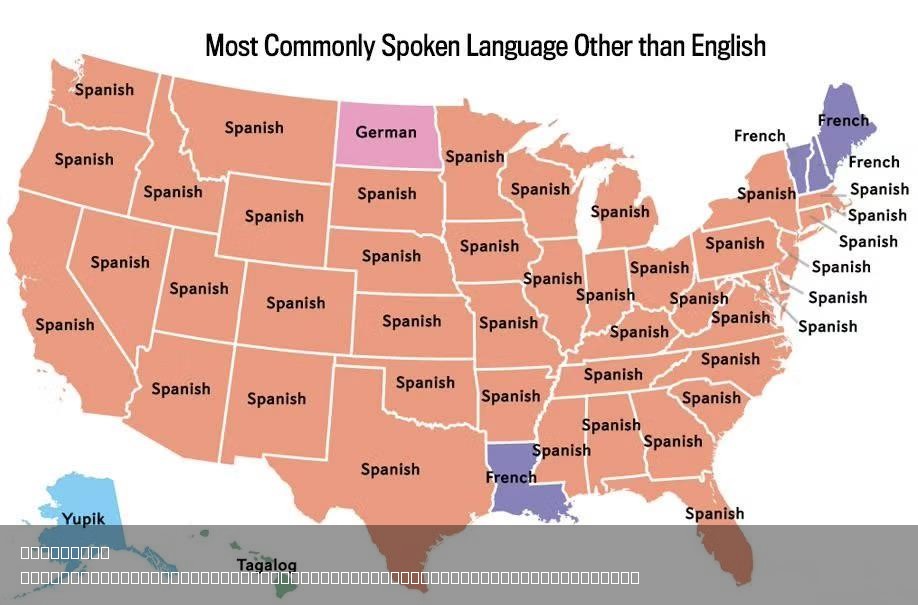Map of Most Commonly Spoken Languages by State


David Chen
Data Visualization Specialist
David Chen is an expert in transforming complex geographic datasets into compelling visual narratives. He combines his background in computer science ...
Geographic Analysis
What This Map Shows
This map illustrates the most commonly spoken languages in each U.S. state, excluding English. It highlights the linguistic diversity across the country, providing a snapshot of the rich tapestry of cultures that contribute to the American identity. By analyzing this visualization, we can gain insights into the demographics and migration patterns that have shaped the language landscape of the United States.
Deep Dive into Language Diversity
Language is a powerful marker of identity and culture. Interestingly, the United States is a melting pot of languages due to its history of immigration and indigenous populations. According to the U.S. Census Bureau, more than 350 languages are spoken across the nation, but the map focuses on the predominant ones in each state.
For instance, Spanish holds the title as the most spoken language after English in several states, including California, Texas, and New Mexico. This is no surprise, as these states have significant Hispanic populations that have contributed to the rich cultural heritage.
In Louisiana, however, the second most common language is French, a remnant of the state's colonial past. The unique Cajun culture and the vibrant Creole language also find their roots in this linguistic history. Similarly, in Hawaii, Hawaiian and Pidgin English are prominent, reflecting the state’s indigenous culture and diverse immigrant communities.
What’s fascinating is the influence of other languages in certain states. For example, in parts of North Dakota, you’ll find a strong German-Russian community, where German is still spoken in many households. Conversely, the presence of Tagalog in Nevada highlights the influence of the Filipino community, which has been growing in recent years.
The diversity in language also illustrates how migration patterns affect local cultures. States like New York and Illinois, with their large urban centers, attract immigrants from around the globe, resulting in a rich mix of languages such as Chinese, Urdu, and Polish.
As we navigate through the linguistic landscape, it’s essential to recognize how language ties into community identity, educational needs, and even economic opportunities. Bilingualism is becoming increasingly important in the workforce, with many employers seeking individuals who can communicate in multiple languages.
Regional Analysis
Breaking down the map by regions reveals distinct linguistic trends. In the Southwest, Spanish dominates, particularly in states like Arizona and Texas, where the Hispanic population is not only large but also influential in shaping cultural norms and local governance. Have you noticed how bilingual signage is becoming more common in these areas?
In the Midwest, while English remains prevalent, languages like German and Polish take precedence in states like Wisconsin and Illinois. This reflects historical immigration waves that have settled in these areas, preserving their linguistic heritage.
Moving to the Northeast, states like New Jersey and New York showcase a mosaic of languages such as Spanish, Italian, and Chinese, driven by diverse immigrant populations. Interestingly, New York City alone is home to speakers of over 800 languages, making it one of the most linguistically diverse cities in the world.
In contrast, the Pacific Northwest, particularly in Washington, emphasizes languages from the Asian continent, with Mandarin being notably prevalent. The significant Asian population in urban areas like Seattle contributes to this trend, showcasing a blend of cultures and languages.
Significance and Impact
Understanding the linguistic landscape of the United States is crucial for multiple reasons. Firstly, it highlights the need for educational resources and policies that accommodate non-English speakers, ensuring inclusivity and access to opportunities. In a country where nearly one in five residents speaks a language other than English at home, addressing these needs is more important than ever.
Moreover, language diversity enriches cultural experiences, fostering greater empathy and communication among different communities. As globalization continues to influence migration patterns, we can expect shifts in the linguistic map, with emerging languages gaining prominence in various states.
Looking ahead, we may see an increase in the demand for language services in healthcare, education, and business sectors as the linguistic landscape evolves. Understanding and embracing this diversity is not just about recognizing different languages; it’s about acknowledging the cultural heritage and contributions of various communities that make up the fabric of America.
In conclusion, this map not only shows which languages are spoken but also serves as a reminder of the rich cultural heritage that exists within the United States. As we move forward, recognizing and celebrating this diversity will be essential for fostering a more inclusive society.
Visualization Details
- Published
- August 2, 2025
- Views
- 130
Comments
Loading comments...